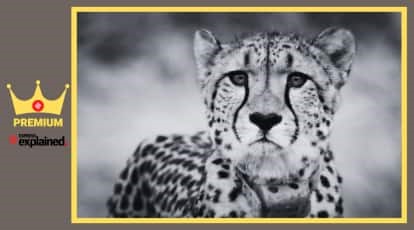Description

Disclaimer: Copyright infringement not intended.
Context
- In Kuno national park, Madhya Pradesh, during last week 2 cheetahs died of suspected septicaemia.
- This is believed to be caused by the neck wounds which again were caused by radio collars.
Other Details
- In 3 other animals too - Oban, Elton, and Freddie, similar kinds of injuries are found.
- In India and Africa, wild cats are collared for monitoring and research purposes
Concerns regarding Radio Collars
- As per a study published in the Journal of Clinical and Diagnostic Research Heavy radio collars are not beneficial for animals for variety of reasons –
- Staphylococcus aureus bacteria were found in higher quantities. These bacteria can lead to sepsis or death.
- Pressure necrosis can be caused by tight-fitting collars leading to loss of hair around the neck area.
- Rain induced humidity also exacerbated the rate of infection caused in neck wounds.

Why are cheetahs most affected?
- More furry coats are grown by Cheetah in winter. When wet it holds more water and takes longer time to dry. Over time this led to a weaker skin of Cheetah.
- Even if the caller weight is low it increases multi-fold due to movements, for example 18 times heavy for a cheetah.
- May be vulnerable to local pathogens.
- Suspected immunity loss due to stress.
Implications
- Concern for preservation of species.
- Setback for the reintroduction project of Cheetah in India.
Measures to be taken
- Keeping the weight of the collar below 3% of body weight of animals.
- Use of special collar integrating motion tracking
- Immediate need to track, immobilise, and check all introduced Cheetah for neck wounds.
- A clear roadmap for next monsoon should be developed to save Cheetah.
- Releasing cheetahs without collars should be experimented.
Kuno National Park
- It is situated in the Vindhyan Hills of Central India, Madhya Pradesh to be specific.
- In 1981 it was started as a wildlife sanctuary and in 2018 was given the status of National park.
- With a total area of 748 sq km, this park lies within the larger Kuno Wildlife Division.

Disclaimer: Copyright infringement not intended.
Flora
- It has tracts of lush green forests, dry savanna forests, Grasslands, etc.
- Flora is dominated by the Kardhai, Dhok, Khair and Salai trees
- Other species are – Tendu, Palash, Grewia flavescens(shrub); and grasses like Heteropogon contortus, Apluda mutica.
Fauna
Mammals –
- Indian leopard, Southeast African cheetah, jungle cat, sloth bear, dhole, Indian wolf, Indian jackal, striped hyena and Bengal fox.
Reptiles –
- Indian softshell turtle, mugger crocodile, gharial, Bengal monitor
Birds –
- More than 100 types of bird species.
- Indian white-backed vulture, long-billed vulture, red-headed vulture, Egyptian vulture, crested serpent-eagle, short-toed snake eagle, Bonelli's eagle, etc.

Must Read Article:
Cheetah in India
https://www.iasgyan.in/daily-current-affairs/cheetahs-in-india
|
PRACTICE QUESTION
A few Cheetah deaths in Kuno National park recently are attributed to the neck injury caused by Radio collars. Elaborate. Also highlight the implication on Project Cheetah. Discuss the way ahead for preventing such deaths in future. (150 words)
|
https://indianexpress.com/article/explained/why-kuno-cheetahs-are-at-extra-risk-due-to-their-radio-collars-8847183/

















